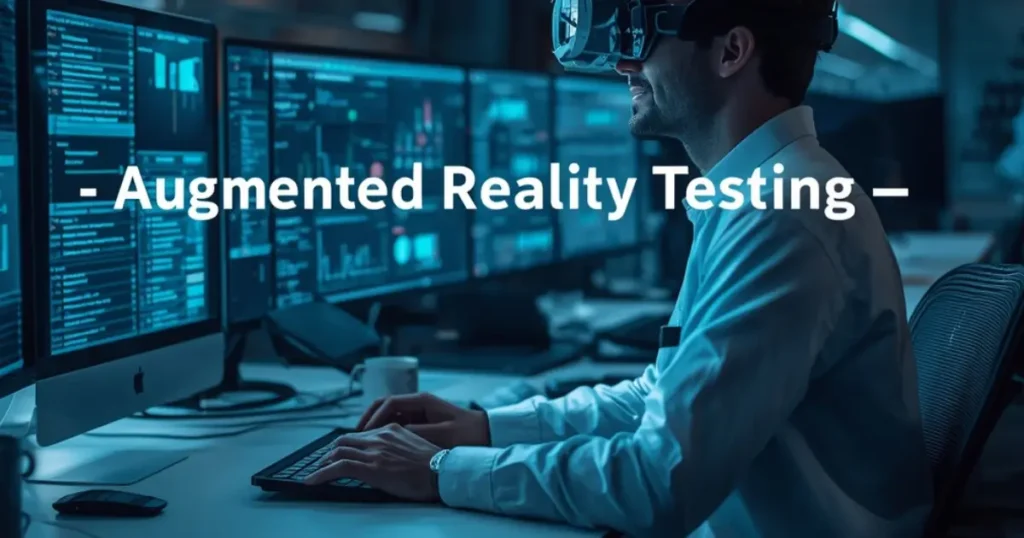
Augmented Reality Testing is a critical component in ensuring the effectiveness and accuracy of AR applications across various industries. As augmented reality continues to shape the future of interactive technology, AR testing has become indispensable for developers aiming to create seamless user experiences. Whether in gaming, healthcare, retail, or education, Augmented Reality is making its mark. But without proper Augmented Reality Testing, the seamless integration of virtual elements with the physical world remains a distant dream. AR testing ensures that the interaction between virtual and real elements performs as expected, delivering the experience that both developers and users anticipate.
In this article, we will dive deep into the importance of Augmented Reality Testing, the tools and techniques involved, the key features to check, and the types of tests needed for a successful AR application.
What is an Augmented Reality Test?
Augmented Reality Testing refers to the process of evaluating the functionality, user experience, and overall performance of AR applications. AR testing ensures that virtual content interacts seamlessly with real-world environments, verifying features such as object recognition, tracking, and environmental interaction. The goal is to identify any issues or bugs that could affect the AR app’s performance across devices, locations, and network conditions.
Through Augmented Reality Testing, developers can verify that AR applications not only function as expected but also offer an immersive, smooth, and responsive user experience. Proper AR testing guarantees the app delivers the expected results across various scenarios and helps avoid costly post-launch fixes.
How AR Works
Before diving deeper into Augmented Reality Testing, it’s essential to understand how AR functions. Augmented Reality uses several key components that interact in real-time:
- Cameras & Sensors: These devices capture the real-world environment and provide data to the system. They help detect surfaces, objects, and motion.
- Processing Units: AR apps process data from sensors and cameras to create 3D models or virtual overlays that interact with the real world.
- Displays & Interfaces: AR displays the processed information on screens, such as smartphones, tablets, or smart glasses.
- Connectivity: AR systems often rely on cloud computing and artificial intelligence (AI) for real-time processing and data synchronization.
During Augmented Reality Testing, these core components are tested for performance, accuracy, and smooth integration. This is crucial for ensuring the AR application is responsive and immersive for users.
Why is an Augmented Reality Test Important?
Ensures Accuracy and Precision
Augmented Reality Testing is pivotal in ensuring virtual objects are accurately placed and aligned with the real world. The precision of object placement, size, and behavior within the AR space is vital for the realism of the experience. Poor accuracy can lead to “floating” virtual objects, which can cause user frustration. AR testing measures the presence of these virtual objects within the expected areas and ensures they stay aligned even when the device moves or the environment changes.
Enhances User Experience
Testing AR apps enhances the user experience by ensuring there are no bugs or issues with interaction. Augmented Reality Testing helps detect latency, jitter, and other delays in interactions that can break immersion. A seamless experience is a core part of AR’s appeal, and AR testing guarantees that users can engage smoothly with virtual elements in the physical world.
Improves Compatibility
For AR applications to be widely accessible, they need to work across a range of devices and platforms. Augmented Reality Testing ensures the app functions across different screen sizes, device capabilities, and operating systems. Compatibility testing checks whether your app works on smartphones, tablets, and wearable devices, such as smart glasses.
Identifies Performance Bottlenecks
AR apps require significant resources, including processing power and battery life. Performance testing within Augmented Reality Testing helps identify issues such as excessive power consumption, overheating, and poor frame rates. Detecting these bottlenecks during the testing phase allows developers to optimize the app before release.
Boosts Security
AR apps often require access to sensitive information, such as camera feeds and GPS data. Augmented Reality Testing helps identify potential security vulnerabilities and ensures compliance with data protection standards. Testing guarantees that user data is secure and that the app does not expose any sensitive information to unauthorized access.
Key Features of an Augmented Reality Test

Object Recognition and Tracking
One of the core features of Augmented Reality Testing is ensuring that the app can accurately recognize and track objects. Object tracking must be seamless, with the virtual object correctly following real-world objects as they move. AR testing confirms whether the app can keep objects in place, even if the environment shifts or the object moves.
Environmental Interaction
Another critical aspect of Augmented Reality Testing is assessing how the app interacts with the physical environment. Does the app place virtual objects realistically on surfaces? Can it adjust to lighting conditions or different textures? These environmental interactions are essential for creating an immersive AR experience.
Device Compatibility
AR applications must work across a wide range of devices. Augmented Reality Testing verifies that the app functions well on different hardware, from high-end smartphones to entry-level devices, ensuring broad accessibility. Testing also checks if the app performs well on devices with or without LiDAR or depth-sensing capabilities.
User Interface (UI) and User Experience (UX)
UI/UX design is crucial to the success of any AR app. Augmented Reality Testing evaluates the app’s interface for ease of use. It ensures that the app is intuitive, with clear touch targets, readable text, and smooth transitions. A user-friendly interface improves the overall experience and engagement.
Performance Optimization
Augmented Reality Testing also focuses on performance optimization. AR apps are resource-intensive, and AR testing ensures that apps run smoothly without excessive lag or battery drain. Optimizing performance is essential for providing a seamless experience, especially on lower-end devices.
Types of Augmented Reality Tests
Functional Testing
Functional testing ensures that the app’s features work as expected. For AR applications, this includes testing:
- Gesture recognition
- Object tracking
- Rendering
- Virtual and real-world object interactions
Why is Functional Testing Important?
Without proper functional testing, you may encounter issues such as unresponsive gestures, tracking failures, or objects not being recognized correctly. Functional testing is essential to ensure all app features work seamlessly and that users can interact with the AR content as intended.
Performance Testing
Performance testing evaluates how the app performs under various conditions. It measures factors like:
- Speed: How quickly AR content is rendered.
- Responsiveness: How fast the app responds to user input.
- Latency: The time between an action and its result.
Why is Performance Testing Important?
Poor performance can lead to a frustrating user experience. Performance testing ensures the AR app works well across devices and under varying network conditions, providing a smooth user experience.
Usability Testing
Usability testing focuses on how easy and intuitive the app is to use. Usability testing evaluates whether users can navigate the AR environment easily and whether the app’s features are accessible.
Why is Usability Testing Important?
If users find an AR app difficult to use, adoption rates will suffer. Usability testing helps improve the design, making sure it’s user-friendly for all audiences, regardless of technical experience.
Tools & Software for AR Testing
Leading Platforms for AR Testing
- Vuforia: Provides advanced object recognition and tracking capabilities.
- Apple ARKit: A powerful framework for building AR applications on iOS.
- Google ARCore: Android’s solution for building AR experiences.
- Unity AR Foundation: A cross-platform framework that integrates ARKit and ARCore features.
Best Practices for AR Testing
Here are some best practices for conducting effective Augmented Reality Testing:
- Test in different lighting environments to simulate real-world conditions.
- Confirm that the app performs well on various devices and screen sizes.
- Check performance at different network speeds to identify potential bottlenecks.
How to Conduct an Augmented Reality Test
Define Testing Objectives
Start by identifying the key areas that need testing—whether it’s object tracking, interaction with the environment, or device compatibility.
Choose the Right Tools
Select the appropriate testing tools. For example, use ARKit for iOS apps or ARCore for Android apps. Unity’s AR Foundation is great for cross-platform testing.
Simulate Real-World Scenarios
Test the app in various real-world environments, such as low-light conditions and high-traffic areas, to see how it performs.
Gather User Feedback
Beta testing with users can provide invaluable insights that go beyond technical testing, helping you fine-tune your AR application for a better user experience.
Analyze and Optimize
After gathering feedback, analyze the test results to identify areas for improvement. Continually optimize the app for better performance, usability, and accuracy.
Common Challenges in AR Testing
Device Compatibility Issues
Different devices have varying levels of processing power and capabilities, which can affect the performance of AR apps. AR testing helps identify these compatibility issues early.
Tracking and Rendering Issues
AR apps need to accurately track and render virtual objects. Any failures in tracking or rendering can break the AR experience. Augmented Reality Testing ensures that these issues are addressed.
Industries Using Augmented Reality Testing
Gaming & Entertainment
AR testing ensures that gaming apps deliver a smooth, immersive experience with minimal interruptions.
Healthcare & Medical Training
Augmented Reality Testing verifies the effectiveness of AR in simulating medical procedures and improves training experiences for medical professionals.
Retail & Ecommerce
Testing helps improve virtual try-ons and product displays, making AR testing an essential tool for enhancing customer shopping experiences.
Future of Augmented Reality Testing

AI-Driven Testing
AI will play a significant role in automating AR testing by identifying defects and offering suggestions for improvement.
Cloud-Based Testing
Cloud services will enable faster, more efficient testing across multiple devices and environments, accelerating AR testing.
Integration of 5G
The introduction of 5G networks will enhance AR applications, reducing latency and enabling more immersive experiences.
AR Wearable Devices
AR testing will evolve to include wearable devices, requiring new testing techniques to ensure their usability and functionality.
Enhanced Security Testing
As AR apps handle more sensitive data, security testing will become even more important to protect user privacy.
Conclusion
Augmented Reality Testing is essential for developing successful AR applications. It ensures accuracy, improves user experience, and boosts compatibility across devices. As AR technology continues to evolve, so must our testing practices, adapting to new challenges such as AI, 5G, and wearable devices.
Developers looking to harness the power of Augmented Reality must prioritize AR testing to deliver high-quality, engaging experiences that meet user expectations.
FAQs
What is an Augmented Reality Test?
It is a process used to evaluate how well an AR app integrates virtual content with the real world, ensuring it functions correctly and delivers an immersive experience.
Why is AR testing necessary?
AR testing helps identify performance issues, compatibility problems, and usability concerns, ensuring a smooth, seamless AR experience for users.
What tools are used for AR testing?
ARKit, ARCore, Vuforia, and Unity AR Foundation are popular tools used for testing AR applications.
How do you test AR applications?
AR testing involves defining objectives, selecting appropriate tools, simulating real-world scenarios, gathering feedback, and analyzing performance metrics.
What are the key features of AR testing?
Key features include object tracking, environmental interaction, device compatibility, UI/UX design, and performance optimization.


